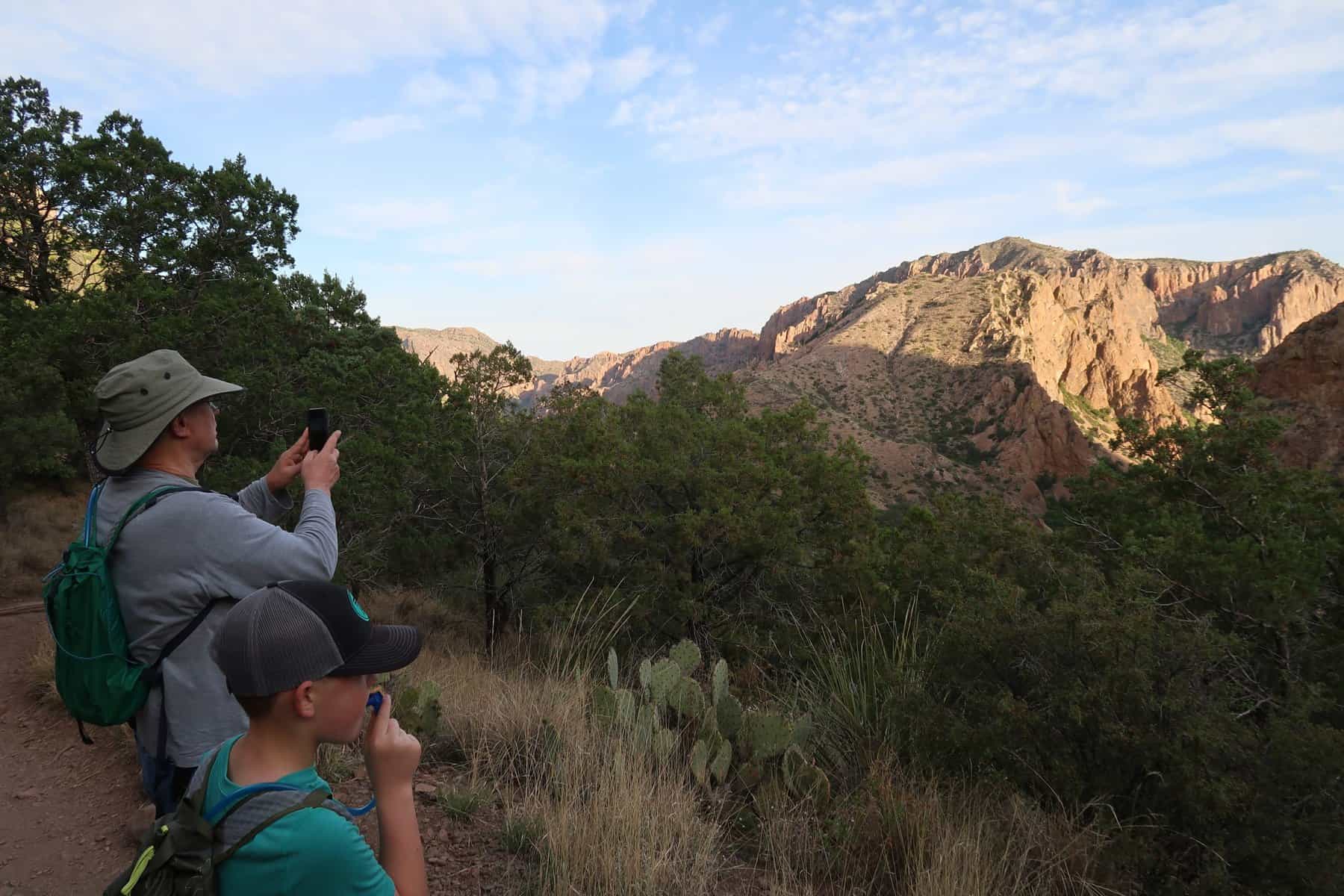Big Bend National Park offers some of the most diverse hiking opportunities in all of our national parks. Spanning over 801,000 acres, you can enjoy mountains, rivers, hot springs, ruins, and desert.
Hiking in Big Bend National Park is much like “choose your own adventure.”
For those of you hiking with children, especially ten-years-old and younger, my top two trail suggestions are the Santa Elena Canyon Trail and the Window View Trail.
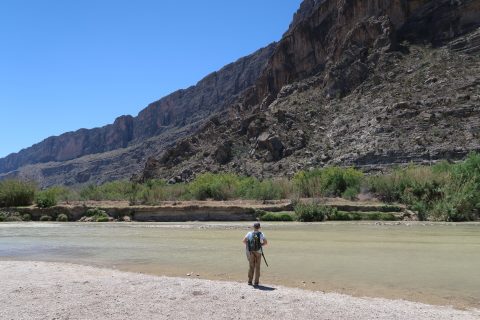
Continue reading for a list of the top Big Bend National Park hiking trails, an explanation of each experience, and, very importantly, hiking safety in Big Bend National Park.
How to prepare for hiking in Big Bend National Park
While Big Bend is diverse and unique in its offerings, it is also among the most dangerous United States national parks.
In fact, both my own experience and the statistics of deaths per million visitors show that Big Bend National Park is the MOST dangerous national park in the contiguous 48 states.
You MUST take safety very seriously here.
The following preparations are necessary for a safe hiking experience in Big Bend:
- Wear footwear with good traction. Hikers will encounter slippery, gravel trails and dangerous ledges.
- Bring a map and compass. No matter how prepared you are for a hike, getting lost in the desert can quickly cost you your life.
- Know the weather forecast. Big Bend spans from mountains to desert. Each region has its own forecast and dangers. Heat, lightning, and flooding are all life-threatening in this park. Carefully choose when to visit this park, and know the best time to visit Big Bend.
- Hike in groups. Check on each other’s wellness. Collaborate on trail directions. Collectively, keep eyes out for animals and reptiles.
- Keep children close. A rattlesnake bite is even more deadly for children, and both bears and mountain lions are hunting in Big Bend. In our experience with Big Bend, the mountain lions are the greater threat to children.
- Watch where you walk. Rattlesnakes and cactus are omnipresent. Read more about the rattlesnake hazards.
- Wear sunscreen. There is little shade in Big Bend, and skin burns quickly there.
- Pack plenty of food and water. Dehydration happens quickly, and many of Big Bend’s trails are long and remote. We NEVER hike in desert anymore without hydration tablets or packets such as NUUN or Liquid IV. Bring these with you. We are pretty sure that Liquid IV saved my husband’s life last April in Big Bend!
- Pack more water. On the safe side, double your water.
- More water. You won’t find much in the desert!
- Use a GPS tracker. Especially if you are hiking alone!
We love Big Bend National Park, and you will, too. Just remember that this is a land that will remind you of the power of nature!
Top Hiking Trails in Big Bend National Park
Given the size and landscape of Big Bend, I have separated the hikes into regions. I do suggest that you make an effort to see each region of the park, even if you don’t have time or energy for a trail!
The Chisos Basin: The Heart of Big Bend
This is my favorite park of the park. It rests high in the mountains at an elevation of 5,400 feet. You will enjoy views of rusty-red mountains and the evergreens that pop against their background.
You will be less likely to run into angry rattlesnakes than when you are in the lower desert, but you will be more likely to spot a bear or a mountain lion.
The best overall trail is the Lost Mine Trail.
This moderate hike is around five miles and opens up to breathtaking vistas of the park. For those that can’t or won’t be able to take in the views of the South Rim Trail, the Lost Mine Trail is a fantastic alternative.
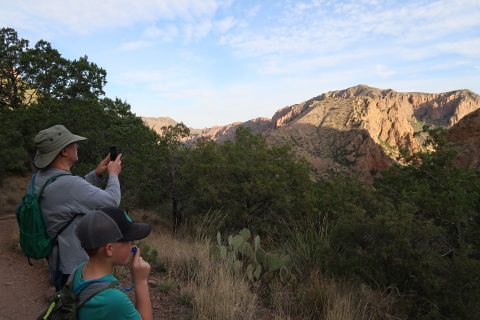
Is the lost mine trail family-friendly?
This trail is best suited for children at least ten-years-old or younger children who have extensive hiking experience (or unrelenting energy!)
The best dayhike with a view is the Window Trail.
This moderate trail descends down towards the base of a “V” where two mountains meet. The view is spectacular, especially at sunset. The out-and-back hike is over five miles long with a 900 foot elevation ascent on the return.
Is the Window Trail family-friendly?
While the Window Trail is family-friendly, we suggest that only strong, experienced hikers tackle this journey. Ascending 900 vertical feet in 2.5 miles may leave you breathless and create a full hiking hour of whimpers for our less enthusiastic hiking buddies!
The best hike for non-hikers is the Window View Trail.
The Window View Trail, not to be confused with the more challenging “Window Trail,” is one of my favorite hikes in Big Bend. This loop is just under half-a-mile and begins at the Chisos Basin Visitor Center.
Pro Tip: Both the Window Trail and the Window View Trail offer our favorite sunset views at Big Bend National Park!
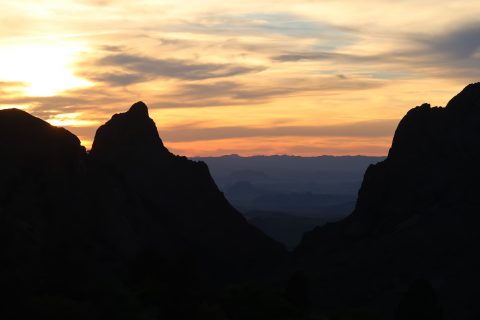
Is the window view trail family-friendly?
Yes! The Window View Trail is so family-friendly that it is paved. You can wheel a wheelchair or a stroller along this short trail.
For those of you that have kiddos who don’t want to hike anymore (for the day or forever,) the Window View Trail is what I like to pitch as an “overlook.” This is my code for a very short hike, under a mile, that I don’t want to call a “hike” to avoid a child’s protest!
You’re welcome!
The best hike for mountain enthusiasts is the Emory Peak Trail.
This trail is approximately 10.5 miles long round trip and is considered a strenuous hike. As hikers ascend, they pass through woodlands, rocky outcrops, and exposed sections. Along the way, you will enjoy scenic views of the surrounding Chisos Mountains.
This hike involves portions of steep stairs and switchbacks. The highlight of the trail is reaching the summit of Emory Peak, the highest point in the Chisos Mountains at 7,825 feet.
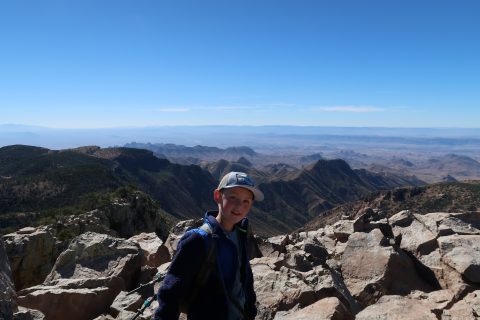
Is the Emory Peak Trail Family-Friendly?
Generally speaking, no, the Emory Peak Trail is not family-friendly. This is a strenuous hike and should be enjoyed by serious hikers and those with appropriate fitness levels for the challenge.
Having said that, my son, pictured above, did hike this trail for the first time when he was ten-years-old.
The best backpacking trail or most intense day hiking trail is the South Rim Trail.
This trail is approximately 12.6 miles long as a loop and is considered a strenuous hike. The trail begins at the Chisos Basin Visitor Center, and hikers can choose to start in either direction for the loop.
As hikers ascend, they’ll encounter breathtaking views of the Chisos Mountains, deep canyons, and the Chihuahuan Desert.
The South Rim Trail is the most popular backpacking trail in Big Bend National Park. The park publishes a backcountry camping guide for the Chisos Basin.
Is the South Rim Trail family-friendly?
Generally speaking, no, the South Rim Trail is not family-friendly. It is a challenging hike that takes hikers into the remote backcountry. This trail is safest for strong, experienced hikers.
The Low Desert Trails of Big Bend
While the Chisos Basin is in the “high desert,” these “low desert” trails offer their own, distinctive views.
The best overall desert trail in Big Bend is the Santa Elena Canyon Trail.
It is a can’t miss trail, and it happens to be perfect for families! The trail is under two miles and leads hikers across the river, along the canyon wall, and deep into the dark, sand-bottomed canyon.
Is the Santa Elena Canyon Trail Family-Friendly?
Yes! People of all ages love this hike. There may be some obstacles to navigate based on the river level, any washed-out sections, proximity to the canyon rim, and cactus and critters. However, with proper precautions, this is a most cherished trail that kids adore!
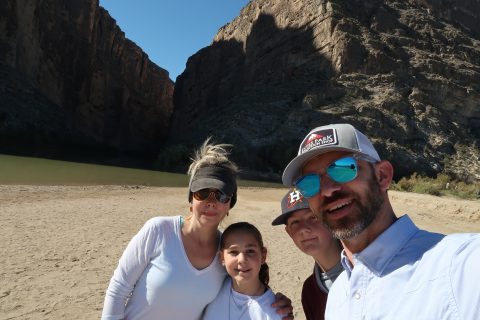
The best trail for budding geologists is the Tuff Canyon Trail.
This trail is about a mile loop that guides you from the scruffy, desert flats through the steep walls of the canyon. Your budding geologist will enjoy knowing that these canyon walls were formed by volcanic tuff which was created from volcanic ash.
For our rock history lovers, the geologic history of Big Bend is definitely worth a preview!
Is the Tuff Canyon Trail Family-Friendly?
Yes, the Tuff Canyon Trail is family-friendly. While there is some uneven terrain to navigate, any family members who are sure-of-foot will enjoy this short hike.
The best hike to a desert oasis is the Mule Ears Spring Trail.
This moderately challenging, four mile out-and-back trail will lead you into a desert oasis!
The spring area supports diverse vegetation which makes it an excellent spot for birdwatching and observing desert flora.The spring only trickles, but it is precious as gold in this desert climate.
Mule Ears Peaks are two prominent rock formations resembling the ears of a mule, and these landmarks give the trail its name.
Is the Mule Ears Spring Trail Family-Friendly?
Yes, the Mule Ears Spring Trail is family-friendly. It is on the slightly more challenging end of family-friendly hikes due to its four mile length, so be sure your little hikers are primed with energy, snacks, and water!
Hikes along the Ross Maxwell Scenic Drive
This drive stretches approximately 30 miles through the park’s western region. Many of the park’s most famous viewpoints are along this route, showcasing rugged mountains, expansive desert scenery, and geological formations.
The best hike for kids or people who enjoy some scrambling is the Grapevine Hills Trail, also known as the Balanced Rock Trail.
At just over two miles, this relatively easy hike offers great views of desert plants and the red rocks. It requires a six mile drive down a rough road, but you will enjoy the payoff of the famed, “Balanced Rock.”
Is the Grapevine Hills Trail Family-Friendly?
Yes, the Grapevine Hills Trail is family-friendly.
The best short, easily accessible hike along the Ross Maxwell Scenic Drive is the Lower Burro Mesa Pour-Off Trail.
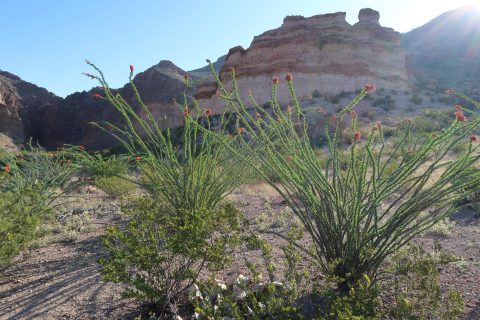
This 1.5-mile-trail routes visitors through a wash that is surrounded by step, layered canyon walls. There is some uneven terrain, so it is classified as a blend of easy and moderate conditions.
After a rain, the eroded pour-off showcases a cascade of water that is a rare sight in the desert.
Is the Lower Burro Mesa Pour-Off Trail family-friendly?
Yes, the Lower Burro Mesa Pour-Off Trail is family-friendly. In fact, due to its short length, this is a great hike for younger children or for those who don’t love to hike.
Trails in the Rio Grande Village Region: Explore the Riverfront
Welcome to the eastern portion of Big Bend National Park! The Rio Grande Village is best known for historic ruins, hot springs, and the Boquillas border crossing.
The best hike for our hot springs lovers is the Hot Springs Historic Trail.
This one mile round-trip hike guides visitors past historic structures and down towards the Rio Grande.
You will walk along the riverbank until you come upon the hot springs. The spring water is partially captured by a stone tub where you can enjoy a bath in the toasty water.
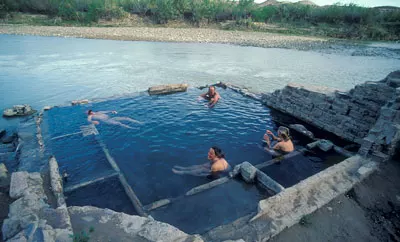
Is the Hot Springs Historic Trail family-friendly?
Yes, the Hot Springs Historic Trail is family-friendly. Even if the hot springs aren’t your kids’ cup-of-tea, they will enjoy tipping fingers or toes in the warm waters!
The best hike for international enthusiasts is the Boquillas Canyon Trail.
This 1.3 mile trail ascends a stairway to the river overlook where you can enjoy sweeping vistas of Mexico. For those interested in crossing into Mexico, please review the National Park information and updates on this process.
Is the Boquillas Canyon Trail family-friendly?
Yes, the Boquillas Canyon Trail is family-friendly. This is a short, relatively easy hike that showcases the Rio Grande River.
Pro Tip: If you have to choose between the Boquillas Canyon Trail and the Hot Springs Historic Trail, children will likely prefer the Hot Springs Trail due to the exciting, spring water.
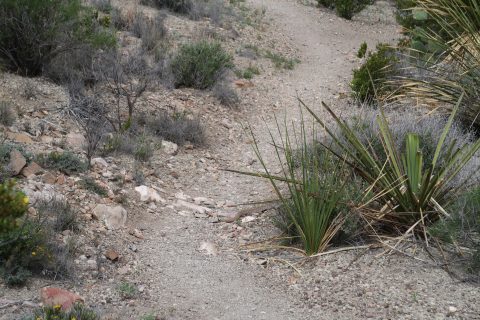
Where to Night Hike at Big Bend National Park
BIg Bend is an International Dark Skies Park. Seeing the Milky Way during a summer’s new moon is a bucket-list-worthy experience.
However, hiking at night in the desert is not for the faint of heart.
Beware of rattlesnakes, cactus, and nocturnal predators such as mountain lions.
Ensure you have adequate light such as headlamps and flashlights. If you intend to enjoy the night sky, a red-colored light is preferable to preserve the view.
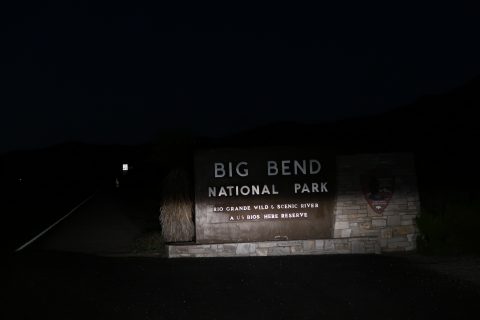
The trail you choose should depend upon the moon phase.
If you are hiking under the light of a full moon, you may prefer a canyon hike. The light of the moon will reflect off the canyon walls in magical patterns.
For a full moon hike, we suggest the first portion of the Santa Elena Canyon Trail or the Boquillas Canyon Trail.
However, if you are hiking on or close to a new moon, you may prefer a trail with expansive views of the night sky.
For a dark, new moon night hike, we suggest the Mule Ears Spring Trail or, for a big adventure with an epic payoff, the upper portion of the South Rim Trail.
Read more about other top attractions and activities to enjoy at Big Bend. No matter how or where you choose to hike Big Bend National Park, we wish you fun, safety, and a lifetime of memories!

